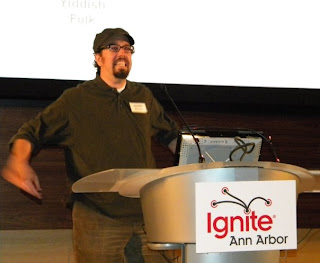I recently gave a talk on Jewish art music. While prepping for the talk I realized that I couldn't find recording's of two fascinating piece. Here's the story of the first.In the 1830's and 1840's,
Giacomo Meyerbeer owned grand opera in Europe. His opera's
Robert le Diable (1831),
Les Huguenots (1836),
Le prophète (1849), and
L'Africaine, (which was produced posthumously in 1865) were immensely popular and critically acclaimed.
Unlike
Felix Mendelssohn, and many other Jewish artists of the time, who either converted to Christianity, or attempted to downplay their Judaism, Meyerbeer was a committed Jew. While Meyerber never directly included references to Judaism in his operas, he was known at the time for his inclusion of religious, as well as religious tolerance, themes.
Born in Tasdorf, near Berlin, Meyerbeer's given name was Jacob Liebmann Beer. He was the son of Jacob Judah Herz Beer and Amalia Liebmann Meyer Wulff, both from wealthy Jewish elite families and active in the Jewish community in Berlin...a community that was busily contributing to what would become the Reform movement and contributing to a renaissance in both traditional and modern Jewish liturgical music.
The renaissance was being driven by Louis Lewandowski (Berlin), Salomon Sulzer (Vienna), and Samuel Naumbourg (Paris). These great cantors and composers were creating a new Jewish liturgical music that took in equal parts traditional nusach and Western classical music. The result was both the basis of modern chazzanut (cantorial singing) and controversial innovations such as the inclusion of the organ into Jewish liturgy.
In this atmosphere Meyerbeer, the reigning king of the grand opera, received a commission that he didn't like but couldn't say no to. His father, who had started an early Reform temple in his home, commissioned Meyerbeer to compose a piece for choir and organ. Meyerbeer was firmly against the use of organ in Jewish music, thinking it a shallow apeing of Christian music and an interference with man's direct communion with God through prayer. Yet he composed the Hallelujah anyway.
The manuscript for Meyerbeer's Hallelujah exists, and is held by the US Library of Congress. But I haven't been able to find any recording, or even evidence of public performance in the last few decades. I have no idea why not.
Another great Meyerbeer story....why are Meyerbeer's operas not performed often any more? Two main reasons. First, they're huge performances requiring large numbers of expensive lead and secondary performers. Second, after his death Meyerber's music was denounced by his most notable musical protege, the next king of opera and raging anti-semite, Richard Wagner.
For more info on Meyerbeer see his
wikipedia page and the wikipedia page "
The Reform Jewish Cantorate during the 19th Century," David Conway's excellent resource
Jewry in Music, and the Jewish Virtual Library page
"Judaic Treasures of the Library of Congress: Giacomo Meyerbeer." Also, hat tip to YouTube user
LindoroRossini for uploading the Meyerbeer opera video. There are lots more
video recordings of Meyerbeer compositions on Youtube, check 'em out.












